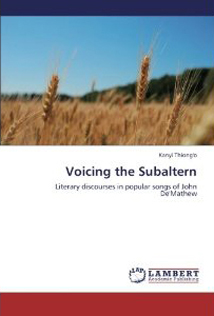
Voicing the Subaltern: Literary Discourses in Popular Songs of John De’Mathew by Kanyi Thiong’o, Lambert Academic Publishing, 2012.
When Philip Tagg lamented that popular music was not being taken seriously enough to be taken up for academic scrutiny, he might as well have been speaking of contemporary East Africa where, except for a small group of scholars such as Mbugua wa Mungai, Evan Mwangi, Tom Odhiambo, James Ogude and Joyce Nyairo, popular music and indeed popular culture in general has been received with extreme critical neglect. With his new book Voicing the Subaltern: Literary Discourses in Popular Songs of John De’Mathew, Kanyi Thiong’o makes his critical debut and joins this small group by taking up the music of John De’Mathew, a Gikuyu popular music artist, as his object of study.
Thiong’o must be commended for breaking the ground with this study of one of the most prolific and perhaps most politically active Gikuyu artists. He takes upon himself a huge task to study and analyse De’Mathew’s “popular songs as a literary genre … and the impact that digital technology has had on the nature of performance of popular songs” (6). Thiong’o’s work and its reading falls loosely under what Marx Brzezinski calls “political formalism”, which aims to “politicise aesthetics”. This is evident in the structure of the book, its scope and the chosen field of investigation. Thiong’o sets out “to analyse the major concerns encompassed in John De’Mathew’s songs … and the stylistic devices that feature prominently in his songs” (vii).
The book is divided into three main chapters. The first chapter encompasses the introduction of the book and it lays down Thiong’o’s objectives as well as the procedure of meeting them. In chapter two he examines the “thematic concerns” and “ideological standpoints” inherent in the chosen songs. Chapter three investigates the significance of “styles”, performance and the use of technology in De’Mathew’s artistic production. The final chapter concludes by suggesting possible spheres of interrogation for future works on De’Mathew: the autobiographical voice, a gender study, and a critical analysis of oral nuances in the songs (147).
Thiong’o’s book is enriched by his comparative analysis of the audio versions of songs that De’Mathew had sung in the 1980s and early 1990s before video technology gained currency in East African music sphere, as well as audio-visual versions that came later in De’Mathew’s music career. For Thiong’o, while the audio tracks can stand alone as independent creation, the visual enhancements of the songs complicate and complement the audio format by “generating secondary themes” (121). Where the audio/verbal text is remains subject to semantic indeterminacy, one way of resolving this comes when one reads the audio text alongside the visual representation of the same song, although De’Mathew later embedded video performances in the earlier audio tracks as a marketing strategy.
Thiong’o gives a good example of the imagery of “Mugumo” which means fig tree in the song titled “Nyumba mwi Nau”. In the audio format the concealed image becomes clear that the fall of “Mugumo” refers to the political demise of the Kenya African National Union, the ruling party in Kenya during the autocratic regime of Daniel Arap Moi. To a great extent, Thiong’o’s comparative approach has helped him navigate some of the indeterminate moments in De’Mathew’s work. By resorting to the reading of the audio-visual texts, Thiong’o’s book has been able to resolve the semantic limit imposed on the audio genre successfully.
Apart from the semantic indeterminacies in De’Mathew’s songs, his work is also deepened by phonological ambivalence. Even among Gikuyu proficient speakers, this complexity is a source of debate. A good example is in a section of the song “Nengereria Kane” – literally “Pass me Kane”, referring to the Gikuyu appropriation of strong hard alcoholic brews which have resulted in the deaths of quite a number of Kenyan youth. I would offer a different transcription from the one Thiong’o gives though we speak the same Gikuyu language in which De’Mathew sings. This would in turn lend our two versions to two different semantic interpretations. Take, for example, Thiong’o’s translation on page 192:
Thiong’o’s transcription My transcription Thiong’o’s translation My translation
Ng’ombe iri kugua nyita Gitongo’e I
Cinyuire Githima kiri ciura iragamba
Ni Ngo’mbe iriku mwanyita gitongoe I
Cinyuire githima kiyuire ciura iragamba
The cows are falling, hold onto the tail
They have drunk from a well full of noise making frogs
Which cows have you held by the tail
To drink from a well full of noisy frogs
Yet, while a cursory glance would (dis)qualify Thiong’o’s transcription and hence the subsequent translation as wrong or incorrect, I would choose to look at our different renditions as being the result of the phonic multiplicity and semantic diversity De’Mathew’s songs lend themselves to.
A few things need to be pointed out about the book. While its completeness in the present form is in no doubt, this work would have benefited the reader more if a biography of De’Mathew, even in a brief form, were included. And perhaps this is missed because of the methodological take-off of Thiong’o’s work. While seemingly unimportant to the study, an interview with the artist would have helped Thiong’o unpack what he calls “ideologies that inform De’Mathew’s work” (vii). By the end of the book the reader is constantly asking: Who is this man De’Mathew? Further, a great percentage of the book seems devoted to a predominantly stylistic reading of the musical texts without in-depth reference to political currents.
Read more by Kimani Kaigai on SLiPnet:
 SLiPStellenbosch Literary Project
SLiPStellenbosch Literary Project